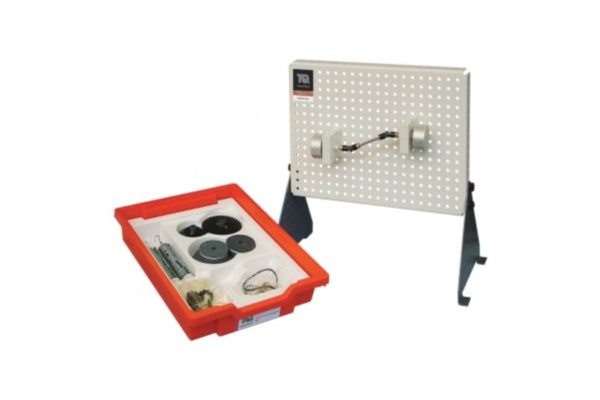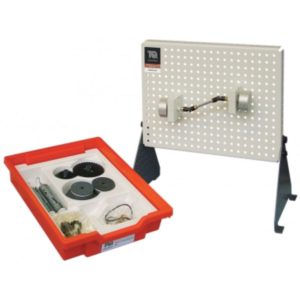
Drive Systems Kit

Demonstrates the advantages and disadvantages of three popular drive systems: belt, chain, and a universal coupling, using a manually rotated frame with a low friction cantilever linkage, adjustable masses, and a spring to apply force.
Features
This kit includes three different drive systems to show their relative advantages and disadvantages. The kit includes extra parts to help show the importance of the angle of lap around a pulley and its relationship with friction.
The kit introduces students to key engineering terms such as gear ratio, pulley ratio, and efficiency.
Students test a universal coupling, a belt drive, and a chain drive to see how they work and how they differ in the way they transfer motion (power).
This versatile kit is part of a series that allows many experiments using different arrangements of their parts. Students, teachers, or lecturers fit the parts of the kit to the Work Panel (ES1) (supplied separately) to study or show an engineering science topic.
TecQuipment supplies a CD-ROM with the Work Panel (ES1). It includes all the worksheets, guidance notes, and lecturer notes (with answers) needed for typical experiments with each kit. The selection of parts in the kits and the choice of fixing points on the Work Panel means that teachers or lecturers may extend the experiments to an even greater range.

Additional Info
| Learning Outcomes: | Power transfer, efficiency, and direction in a belt drive Power transfer and efficiency in a chain drive Input and output relationships of a universal coupling Friction and angle of lap on a pulley Power transfer, efficiency, and direction in a belt drive Power transfer and efficiency in a chain drive Input and output relationships of a universal coupling Friction and angle of lap on a pulley |
| Curriculum Check: | NSW: Module 1 Module 3 VIC: Unit 1 - Area of Study 1 - Outcome 1 Unit 3 - Area of Study 1 - Outcome 1 QLD: Unit 4 - Topic 1 WA: Unit 2, Unit 4 TAS: Learning Outcomes included in Curriculum |
| Specifications: | PDF Datasheet |




 Our friendly and knowledgeable service and support team is based in Sydney, Australia. They are on hand and happy to help with your sales and support queries.
Our friendly and knowledgeable service and support team is based in Sydney, Australia. They are on hand and happy to help with your sales and support queries. We’ve carefully selected the highest quality equipment and systems from around the globe to bring world-class technology to Australian and New Zealand educational facilities.
We’ve carefully selected the highest quality equipment and systems from around the globe to bring world-class technology to Australian and New Zealand educational facilities. Our parent company,
Our parent company, 

